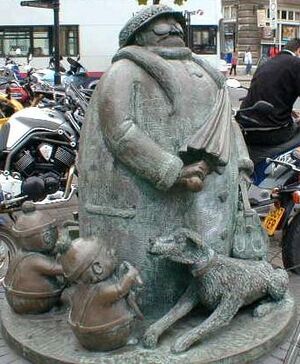Carl Giles facts for kids
Quick facts for kids
Carl Giles
|
|
|---|---|
| Born | 29 September 1916 Islington, London, U.K.
|
| Died | August 27, 1995 (aged 78) Ipswich, London, U.K.
|
| Occupation | Cartoonist |
| Known for | Giles family |
| Awards | OBE |
Ronald "Carl" Giles (born September 29, 1916 – died August 27, 1995) was a famous cartoonist. People often just called him Giles. He worked for a British newspaper called the Daily Express.
His cartoons were usually single pictures with lots of detail. They often had more going on than just one joke. Some characters became very popular, especially the Giles family. This cartoon family first appeared on August 5, 1945, and was a big part of his work.
Contents
Early Life of Carl Giles
Giles was born in Islington, London. His dad sold tobacco, and his mom was a farmer's daughter. Friends nicknamed him "Karlo" because they thought he looked like the actor Boris Karloff. This nickname was later shortened to "Carl," and he even used it when he died.
He left school at 14 and started working for an advertising company called Superads. This company made animated films. Giles gained experience in other small film companies. By 1935, he became an animator. He worked on a color cartoon film called The Fox Hunt. Later, he joined a studio in Ipswich to help make animated films based on a popular newspaper comic strip.
Giles's Cartoon Career
In 1937, Giles began working as a cartoonist for a newspaper called Reynolds News. He drew a weekly cartoon about current events and a comic strip called "Young Ernie." The editor of the Sunday Express noticed his work.
In 1943, Giles was offered a job at the Daily Express and Sunday Express. He got a higher salary, so he left Reynolds News. His first cartoon for his new employers appeared on October 3, 1943.
Giles later said he didn't always agree with the Daily Express's political views. He felt a bit bad for leaving Reynolds News, which had different views. But working for the Daily Express made him very successful. By 1955, he was earning a lot of money for drawing three cartoons a week.
Giles could not join the army during World War II because he had problems with his sight and hearing. However, he made animated short films for the government. Some of his cartoons were even printed as posters. In 1945, he became a "War Correspondent Cartoonist" for the Daily Express. This meant he traveled with the 2nd Army to draw about the war.
During the war, he was assigned to a unit that helped free the Bergen-Belsen concentration camp. Giles met the camp's commander, Josef Kramer. Kramer knew Giles's cartoons and admired them.
In 1959, Giles received an OBE award. Even the British Royal Family were fans of his work and often asked for his original drawings.
Giles's cartoons often included references to news stories. The topics were usually about British life and common British things. For example, one cartoon showed a cleaner who accidentally locked herself out of a room near the throne.
Giles stopped working for The Daily Express in 1989. He felt his cartoons were getting less space in the newspaper. He continued working for the Sunday Express until 1991.
He never sold his original cartoons. Instead, he gave them to friends and to charities like the RNLI (a lifeboat charity). He was a Life President of the RNLI, and they still use his work on charity Christmas cards every year. He also drew cartoons for other magazines and for advertising.
Giles's Personal Life
Giles married Sylvia 'Joan' Clarke, who was his first cousin, on March 14, 1942. They were married for over 50 years and did not have children. Soon after they married, they moved to Witnesham, near Ipswich, Suffolk. They lived there for the rest of their lives.
In his later years, Giles had health problems, including losing his sight and hearing. In 1990, he had both legs amputated because of poor blood circulation. He was very sad after his wife died on Christmas Day in 1994. Giles himself passed away just over eight months later, on August 27, 1995, at Ipswich Hospital. He was 78 years old.
Annual Cartoon Collections
Collections of Giles's cartoons have been published every year since 1946. Until his death in 1995, Giles himself chose which cartoons would be in the yearly book.
Before 1991, the annual books contained cartoons from the previous year. For example, the book published in autumn 1989 had cartoons from June 1987 to June 1988. After 1991, the books started including cartoons that had been in earlier collections, or some that had never been published in a collection before.
Many of the annual books included a special introduction. These were written by editors of the Express newspapers or by famous fans. Some of these fans included ballet dancer Margot Fonteyn, singer Adam Faith, and actor Sean Connery.
In June 2017, a book called 'Giles's War' was published. It was the first biography of Giles based on his own letters. This book showed that Giles had not been completely honest about why he left Reynolds News.
Giles's Influence and Tributes
Giles said that other cartoonists like Bruce Bairnsfather and Graham Laidler (known as "Pont") influenced his work. In turn, Giles influenced other newspaper cartoonists. His cartoon from January 13, 1953, called 'Back to School Week', even inspired the creation of 'The Bash Street Kids' for The Beano comic.
In April 2000, Giles was voted 'Britain's Favourite Cartoonist of the 20th Century'.
In 1993, a bronze statue of Giles's character "Grandma" was put up in Ipswich, England. She is shown looking up at the window of the studio where Giles used to work. Giles, who was in a wheelchair by then, was there for the unveiling.
He lived in Witnesham and supported the local football team, Ipswich Town F.C.. Giles is buried in the churchyard of Tuddenham St Martin, Suffolk.
Images for kids







